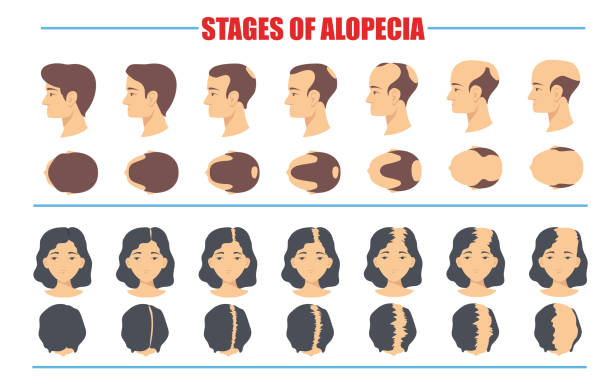A Comprehensive Guide to Hair Health Management: Latest Insights for September 2024
Understanding Hair Loss and Its Treatment Options
Hair loss is a common concern, affecting millions of people globally. It can be classified into two main types: physiological and pathological hair loss. Pathological hair loss refers to abnormal hair shedding caused by various factors, including genetics, immune disorders, stress, medication, hormonal imbalances, and improper hair care routines. If untreated, it may result in increased hair shedding, thinning hair, or bald spots. Fortunately, most hair loss conditions can be improved or cured with the right treatment plan under medical supervision.
Types of Hair Loss
Hair loss is broadly categorized into two types based on follicle damage:
Non-scarring Alopecia: This includes androgenetic alopecia (male/female pattern baldness), telogen effluvium, and alopecia areata.
Scarring Alopecia: Rare conditions like lupus and lichen planopilaris fall under this category.

Androgenetic Alopecia (AGA)
The most common type, androgenetic alopecia, also known as pattern baldness, is linked to genetics and the hormone dihydrotestosterone (DHT). It typically manifests as a receding hairline and thinning at the crown, leading to a "Mediterranean" appearance, where hair remains at the sides and back of the head.
Alopecia Areata
This autoimmune condition causes sudden round patches of hair loss, commonly referred to as "spot baldness." It can affect any part of the body but is most often seen on the scalp. Alopecia areata may be linked to stress, allergies, or genetic predisposition, and is sometimes associated with other autoimmune conditions like thyroid disorders and vitiligo.
Telogen Effluvium
Telogen effluvium is characterized by diffuse hair shedding. It occurs when an increased number of hair follicles prematurely enter the resting (telogen) phase of the hair growth cycle. This can be triggered by stress, surgery, childbirth, or nutritional deficiencies.
Common Causes of Hair Loss
There are several potential causes for hair loss, including:
1.Genetics and Hormones: Androgenetic alopecia is often hereditary and influenced by hormones.
2.Stress and Autoimmunity: Autoimmune disorders such as alopecia areata may be triggered by stress or immune system imbalances.
3.Physical Trauma: Surgery, high fever, or significant stress can lead to telogen effluvium.
4.Nutritional Deficiencies: Lack of nutrients like iron or protein can weaken hair health.
5.Medications and Medical Conditions: Chemotherapy, radiation, and certain drugs can induce hair loss.
6.Improper Hair Care: Tight hairstyles and overuse of hair products can cause traction alopecia.
Effective Treatments for Hair Loss
Hair loss treatments vary depending on the type and cause of the condition. Here are some commonly used approaches:
1. Medication-Based Treatments
For Androgenetic Alopecia: Finasteride and spironolactone (for women) are popular oral treatments. Topical minoxidil is also widely used to promote hair regrowth.
For Alopecia Areata: Topical or systemic corticosteroids and immunosuppressive drugs are prescribed to manage immune-related hair loss. In stubborn cases, newer small-molecule drugs may be used.
2. Low-Level Laser Therapy (LLLT)
Low-level laser therapy (LLLT) is a non-invasive and effective physical treatment for hair loss. Using light at specific wavelengths (such as 650nm or 670nm), LLLT helps to:
Stimulate hair follicles from the resting phase (telogen) back to the growth phase (anagen).
Improve scalp circulation, delivering nutrients to hair follicles.
Reduce inflammation, which can contribute to hair loss.
Effective Treatments for Hair Loss
Hair loss treatments vary depending on the type and cause of the condition. Here are some commonly used approaches:
H3: 1. Medication-Based Treatments
For Androgenetic Alopecia: Finasteride and spironolactone (for women) are popular oral treatments. Topical minoxidil is also widely used to promote hair regrowth.
For Alopecia Areata: Topical or systemic corticosteroids and immunosuppressive drugs are prescribed to manage immune-related hair loss. In stubborn cases, newer small-molecule drugs may be used.
2. Low-Level Laser Therapy (LLLT)
Low-level laser therapy (LLLT) is a non-invasive and effective physical treatment for hair loss. Using light at specific wavelengths (such as 650nm or 670nm), LLLT helps to:
Stimulate hair follicles from the resting phase (telogen) back to the growth phase (anagen).
Improve scalp circulation, delivering nutrients to hair follicles.
Reduce inflammation, which can contribute to hair loss.
Clinical studies have shown that LLLT, when combined with medication, offers enhanced results for androgenetic alopecia, alopecia areata, and telogen effluvium. It’s a safe option for long-term use, making it ideal for those seeking a non-surgical solution to hair loss.
3. Microneedling
Microneedling involves using fine needles to create tiny punctures in the scalp, promoting collagen production and increasing blood flow to the hair follicles. This process enhances the effectiveness of topical treatments like minoxidil by improving absorption.
4. Additional Treatments
PRP (Platelet-Rich Plasma) Therapy: This involves injecting concentrated platelets from your own blood into the scalp to encourage hair regrowth.
Hair Transplants: In advanced cases of hair loss, hair transplants may be necessary.
Cosmetic Options: When other treatments fail, wigs or hairpieces can help restore appearance.
Why LLLT is the Future of Hair Loss Treatment
Low-level laser therapy (LLLT) has emerged as a revolutionary treatment for hair loss due to its non-invasive nature, minimal side effects, and proven efficacy. By utilizing red light wavelengths, LLLT stimulates cellular activity in hair follicles, promoting thicker and healthier hair growth. Unlike hair transplants or medications that may carry side effects, LLLT is painless, making it a convenient and accessible solution for those dealing with hair thinning or balding.
For optimal results, many experts recommend combining LLLT with medications like minoxidil, particularly for patients with androgenetic alopecia or alopecia areata. Clinical studies show that LLLT used consistently for three months or longer significantly reduces hair shedding and promotes regrowth.
